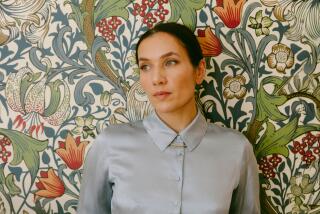The Savvy Resolve Conflict With Complementary Colors
- Share via
W e were yammering away the other day when out of nowhere she said, “That’s a nice color on you. You’re a winter.”
Me: “I’m a WHAT?
And then began the great enlightenment, or at least the beginning of it: how your personal natural coloring--skin tone, hair, eyes--is complemented by certain colors in your clothes. And how you can look pretty awful if you don’t hew to those colors.
Is all this stuff true, or is it just more fashion alchemy to sell books?
HE: I’m beginning to believe it. Some time ago, somebody told me that with my silver-gray hair, green eyes and fair skin I should never wear anything yellow. I went right out and bought a canary yellow sweater and wore it around defiantly for quite a while until I realized it made me look like I’d just escaped from the morgue. Fortunately, my then-girlfriend bought me a bright red sweater for Christmas, and bingo! I was brought back to life.
My brother, a redhead, balked for years at wearing green, insisting it would make him look like a Christmas tree. Then his wife started slipping green stuff into his wardrobe, and now she’s having trouble getting him to wear anything else. Turns out he’s an “autumn” type.
SHE: About 10 years ago, I had my colors “done.” A woman who specializes in the color concepts promoted by “Color Me Beautiful” author Carole Jackson (who uses the four seasons--autumn, spring, winter, summer--to categorize the skin and hair tones nature has given us) had me sit before a mirror while she draped different colored fabrics across my chest.
I couldn’t believe how lousy I looked in oranges, rusts, certain browns and pastels and how absolutely almost-fabulous I looked when she held jewel tones--those appropriate to a winter--next to my face. From that day forward, it was ruby, sapphire, amethyst, emerald, ebony and pearl for me. She said I could get away with just about any color, but that jewel tones would really flatter me.
HE: This whole thing actually got spooky when I realized there are certain suits--perfectly good, beautifully cut, bankbook-draining suits--that can actually look like hell on some guys. I always figured that a suit was a suit and the thing that mattered most was that the thing fit. That was before I tried to resurrect the light gray suit that I’d bought several years ago. It was very good quality, a light steel gray and all it needed was to have the big lapels cut down a bit.
But time had intervened. When I bought it, I had brown hair. Now, with that gray suit against my gray hair, I could be rendered completely invisible on an overcast day.
Chocolate brown? Forget it. Makes me look like a moldy Tootsie Roll.
Navy and black? Damn right! We “winters” are power-suit types, and, if I do say so myself, we wear it well.
SHE: Until I became aware of Jackson’s color guidelines, I didn’t realize how wearing flattering colors made me feel. But, I swear, when I put on a cherry-red or a cobalt-blue dress, my spirits soar. On the other hand, a baby-blue or beige ensemble makes me feel deflated.
In her book, Jackson lists some famous winters: Jacqueline Onassis, Princess Caroline, Diana Ross. Can you picture any of them looking their best in camel (a great color on autumns), rose-beige (good on summers) or tan (super on springs)?
HE: Hey, I can picture Princess Caroline looking good in a space suit.
I don’t think these guidelines are meant to be absolute, but there does seem to be a lot of wisdom in them. And it doesn’t apply just to personal fashion, if you believe some of the people who hang around the NFL. Some of these guys have been claiming for some time now that uniform colors can have an effect on what happens on the field. For instance, Tampa Bay’s uniforms are mostly a happy, cheerful, bright orange and they’re the league’s perpetual goats. On the other hand, teams like Chicago, who wear dark blue, and the Raiders, who wear black, tend to sign guys who genuinely like to hurt people.
SHE: Back to Princess Caroline for a sec. Better make that a ruby-red space suit. I said she wouldn’t look her best in rose-beige, tan or camel.
For fun, here are some other stars and their seasons: Autumns include Carol Burnett, Shirley MacLaine and Katharine Hepburn; among springs are Julie Andrews, Shirley Jones (and Marilyn Monroe), and summers include Cheryl Tiegs, Farrah Fawcett and Caroline Kennedy.
Autumns look wonderful in forest green, orange-red and rust. Put a spring in coral or periwinkle and she (or he) will shine. Summers look their best in raspberry, watermelon and blue-greens.
What it all comes down to, I guess, is getting a head start on looking good. If we know what makes us look terrific, we don’t have to waste our time trying on things we know won’t enhance our appearance.
As Jackson says: “Perhaps the biggest joy in finding your personal colors is the freedom it brings. Shopping will become quick and easy . . . you won’t clutter up your closet with mistakes . . . your palette can be a tool that will simplify your life, leaving you free to pursue other interests.”






